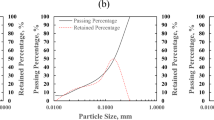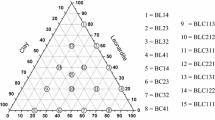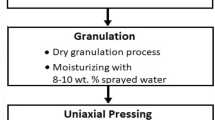Abstract
The idea of reusing municipal incinerator bottom ash (MIBA), the residue from incinerating municipal solid wastes, fits nicely in a circular economy scheme, which leads to an avoided impact of landfill disposal, and at the same time reduces the demand of natural resources. Past studies have attempted to add 20 to 60% MIBA for ceramic production, and resulted in some inspiring success. Focused on delivering quality interior and exterior floor tiles meeting industrial standards, this study investigated the operative conditions and the optimum amount of MIBA in the mix. In this study, only the kaolinite clay and MIBA were used. Before making specimens, raw materials of clay and MIBA underwent SEM, EDS, and TCLP tests to determine their chemical contents. Six sets of specimens with different replacement levels of MIBA (0%, 5%, 10%, 15%, 20%, and 30%) were then prepared. These specimens were fired at 1000°C, 1050°C,1100°C, and 1150°C and the products underwent a series of mechanical tests to verify their performance. NMR (nuclear magnetic resonance spectroscopy) were also used to determining the organic compound structure after each specimens’ crystallization. Research results showed that proper mix of MIBA up to 20% could result in quality tiles complying with specifications for interior and exterior flooring applications at certain kiln temperatures, while the specimens with 30% MIBA failed to meet either bending strength or size shrinkage requirement at all four kiln temperatures, and could not deliver a satisfactory result.




















Similar content being viewed by others
Data availability
The datasets used and/or analyzed during the current study are available from the corresponding author on reasonable request.
References
Andreola F, Barbieri L, Soares BQ, Karamanov A, Schabbach LM, Bernardin AM, Pich C (2019) Toxicological analysis of ceramic building materials – Tiles and glasses – Obtained from post-treated bottom ashes. Waste Management. 98:50–57. https://doi.org/10.1016/j.wasman.2019.08.008
Balapour M, Weijin Zhao W, Garboczi EJ, Oo NY, Spatari S, Hsuan YG, Billen P, Farnam Y (2020) Potential use of lightweight aggregate (LWA) produced from bottom coal ash for internal curing of concrete systems. Cement and Concrete Composites 105:103428, ISSN 0958-9465. https://doi.org/10.1016/j.cemconcomp.2019.103428
Bernd W, Carl FS (1997) Utilization of sewage sludge ashes in the brick and tile industry. Water Science and Technology 36(11):251–258
Bijen JMJM (1986) Manufacturing processes of artificial lightweight aggregates from fly ash. International Journal of Cement Composites and Lightweight Concrete 8(3):191–199
Bourtsalas A (2015) Processing the problematic fine fraction of incinerator bottom ash into a raw material for manufacturing ceramics. Imperial College London, ISNI: 0000 0004 5371 9625
Cheeseman CR, da Rocha SM, Sollars C, Bethanis S, Boccaccini AR (2003) Ceramic processing of incinerator bottom ash. Waste Management 23(10):907–916
Filipponi P, Polettini A, Pomi R, Sirini P (2003) Physical and mechanical properties of cement-based products containing incineration bottom ash. Waste Management 23(2):145–156, ISSN 0956-053X. https://doi.org/10.1016/S0956-053X(02)00041-7
Ganesh S, Khan F, Ahmed MK, Velavendan P, Pandey NK, Kamachi Mudali U (2012) Spectrophotometric determination of trace amounts of phosphate in water and soil. Water Science & Technology. 66(12):2653–2658. https://doi.org/10.2166/wst.2012.468
He Y-J, Hu S-G(2007) Application of 29Si nuclear magnetic resonance (NMR) in research of cement chemistry. Journal of Material Science & Engineering 25(1):147–153
Holmes N, O'Malley H, Cribbin P, Mullen H, Keane G (2016) Performance of masonry blocks containing different proportions of incinerator bottom ash. Sustainable Materials and Technologies 8:14–19, ISSN 2214-9937. https://doi.org/10.1016/j.susmat.2016.05.001http://www.sciencedirect.com/science/article/pii/S2214993715300117
Karamanov A, Karamanova E, Schabbach LM, Andreola F, Taurino R, Barbieri L (2021) Sintering and phase formation of ceramics based on pre-treated municipal incinerator bottom ash. Open Ceramics 5:100044
Lin WY, Heng KS, Sun X, Wang JY (2015) Accelerated carbonation of different size fractions of MSW IBA and the effect on leaching. Waste Management 41:75–84
Liu T, Li X, Guan L, Liu P, Wu T, Li Z, Lu A (2016) Low-cost and environment-friendly ceramic foams made from leadzinc mine tailings and red mud: foaming mechanism, physical, mechanical and chemical properties. Ceram Int 42(1):1733
Lynn CJ, Ghataora GS, Dhir OBE RK (2017) Municipal incinerated bottom ash (MIBA) characteristics and potential for use in road pavements. Int J Pavement Res Technol 10:185–201. https://doi.org/10.1016/j.ijprt.2016.12.003
Sruthi PL, Reddy HP (2020) Effect of Alkali Concentration on Swelling Characteristics of Transformed Kaolinitic Clays. Clays and Clay Minerals 68(4):1–21. https://doi.org/10.1007/s42860-020-00081-x
Schabbach LM, Andreola F, Barbieri L, Lancellotti I, Karamanova E, Karamanov A (2012) Post-treated incinerator bottom ash as alternative raw material for ceramic manufacturing. Journal of the European Ceramic Society 32(11):2843–2852
Tsai C-H, Shen Y-H, Tsai W-T(2020) Taiwan. Resources 9:117. https://doi.org/10.3390/resources9100117
Valle-Zermeño R, Barreneche C, Cabeza LF, Formosa J, Fernández AI, Chimenos JM (2016) MSWI bottom ash for thermal energy storage: An innovative and sustainable approach for its reutilization. Renewable Energy 99:431–436
Acknowledgements
The authors would like to kindly thank Ministry of Science and Technology (MOST), Taiwan for the financial support. We would also like to thank Dr. Huan-Lin Luo of I-Shou University for his insightful opinions for completing this study.
Funding
The work has received funding from Ministry of Science and Technology, Taiwan under grant agreement NSC 101-2221-E-214-063-MY3-1.
Author information
Authors and Affiliations
Contributions
Methodology and project administration by Deng-Fong Lin
Investigation and experiments were performed by Chia-Wen Chen
Analysis and visualization were performed by Chia-Wen Chen and Kuo-Liang Lin
The first draft of the manuscript was written by Kuo-Liang Lin and Show-Ing Shieh.
All the authors commented on previous versions of the manuscript.
All the authors contributed to review and editing according to reviewer’s comments. All the authors read and approved the final manuscript.
Corresponding author
Ethics declarations
Ethical approval and consent to participate
Not applicable
Consent for publication
Not applicable
Competing interests
The authors declare no competing interests.
Additional information
Responsible Editor: Philippe Garrigues
Publisher’s note
Springer Nature remains neutral with regard to jurisdictional claims in published maps and institutional affiliations.
Rights and permissions
About this article
Cite this article
Lin, DF., Lin, KL., Shieh, SI. et al. Study of the operative conditions and the optimum amount of municipal incinerator bottom ash for the obtainment of ceramic floor tiles. Environ Sci Pollut Res 29, 12540–12553 (2022). https://doi.org/10.1007/s11356-021-16742-w
Received:
Accepted:
Published:
Issue Date:
DOI: https://doi.org/10.1007/s11356-021-16742-w




